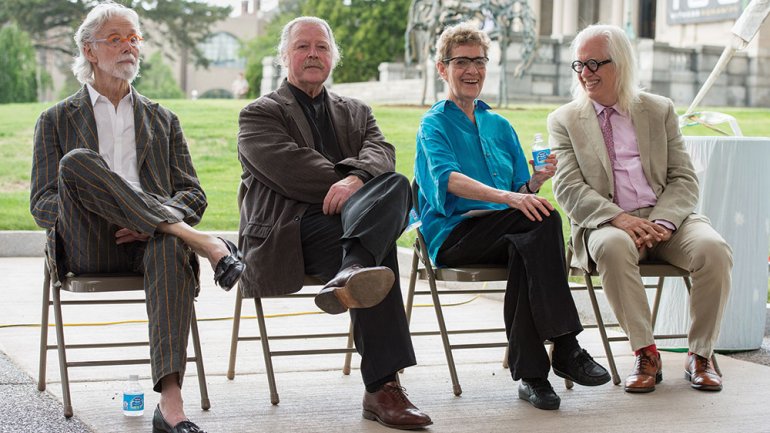Inside Out
Inside Out
If you’re a fan of pioneers in art, craft, and women’s rights, you’ve got new reason to add Rochester, New York, to your must-visit list.
What’s new? Now you can lounge outside in cast-iron chairs beneath a 13-foot LED lamp by Wendell Castle. Stroll on serpentine pathways while translating the Morse code that Jackie Ferrara has embedded in brick. Grasp the pencil wielded by miniature bronze figures of Susan B. Anthony and Elizabeth Cady Stanton in Tom Otterness’ sculpture – or ogle his giant stone sculptor as she wields mallet and chisel to carve her ideal man.
Those are among the many visual and tactile treats now awaiting visitors outside the Memorial Art Gallery of the University of Rochester in its new Centennial Sculpture Park. Its official opening is October 13, but its 17 acres are already studded with about 20 other sculptures, including major pieces by such noted 20th- and 21st-century Americans as Beverly Pepper, Deborah Butterfield, George Rickey, and Tony Smith.
And more are on the way, including the park’s fourth site-specific piece: Soliloquy, a 25-foot-tall, brightly painted stainless steel sculpture by Albert Paley, one of the internationally acclaimed Rochester artists whose career began in traditional crafts (in his case, as a goldsmith).
The park has been in the works for nearly a decade, says MAG director Grant Holcomb, as the institution sought to celebrate its 100th birthday by continuing its original mission of community engagement. Indeed, what made the $4.1 million park possible amid a tough economy were collaborations in planning and funding among the gallery, private donors, and government on every level.
Holcomb envisioned opening up the grounds, bounded since 1926 by a tall wrought-iron fence, and creating a sort of “19th-century New England commons, where, to this day, people gather to meet, talk, read, etc.”
Castle, known as the father of the art furniture movement, says that concept inspired him to create an “outdoor living room” of furniture “tied together as if related, in a recognizable way.” Hence the high-profile horns protruding from the table and three chairs in Unicorn Family. After Castle carved the molds in his nearby Scottsville studio, they were cast in ductile iron in Baltimore, treated with rust-enhancing chemicals that lend the color and streaky pattern of chestnut, then bolted to a 22-foot-diameter brick rug near the park’s entrance. There they beckon to passersby, day and night.
Given a prime site at the park’s busy corner, Otterness designed Creation Myth to link the gallery with its neighboring museums and artists’ studios – and to reflect the region’s history as the cradle of the U.S. women’s rights movement. Reversing the roles of the traditional Pygmalion tale, the Brooklyn artist depicts female sculptors carving male sculptures amid a quarry-like setting that doubles as an amphitheater.
Several massive, cartoonlike figures, composed of simple sphere, cube, cone, and cylinder forms, are rendered in Indiana limestone taken from the same quarry that supplied materials for the gallery’s original building. Scattered throughout the site are about a dozen small bronze figures that depict the creative process, as well as same-sex couples kissing.
Linking the site-specific works with one another, and with surrounding sidewalks bearing words by locally connected writers, are Ferrara’s twining paths. Marking Crossways, paved with cream-, rust-, pomegranate-, and oxblood-colored bricks, uses darker ones in key places to spell out the names of colors and the gallery in the dots and dashes of Morse code.
The Manhattan artist’s device was intuitive – and uncanny. Emily Sibley Averell Watson, the Rochester philanthropist whose donation a century ago created the Memorial Art Gallery, had inherited her fortune from her father, Hiram Sibley, a founder of the Western Union Telegraph empire.
Daughter and father might be pleased to know that her gallery continues to widen its reach using advances in communication technology. Visitors can now use a free app to learn about some of the 12,000-plus pieces in the gallery’s celebrated collection, including those now out on the lawn.
Sebby Wilson Jacobson is a writer and editor in Rochester, New York.

